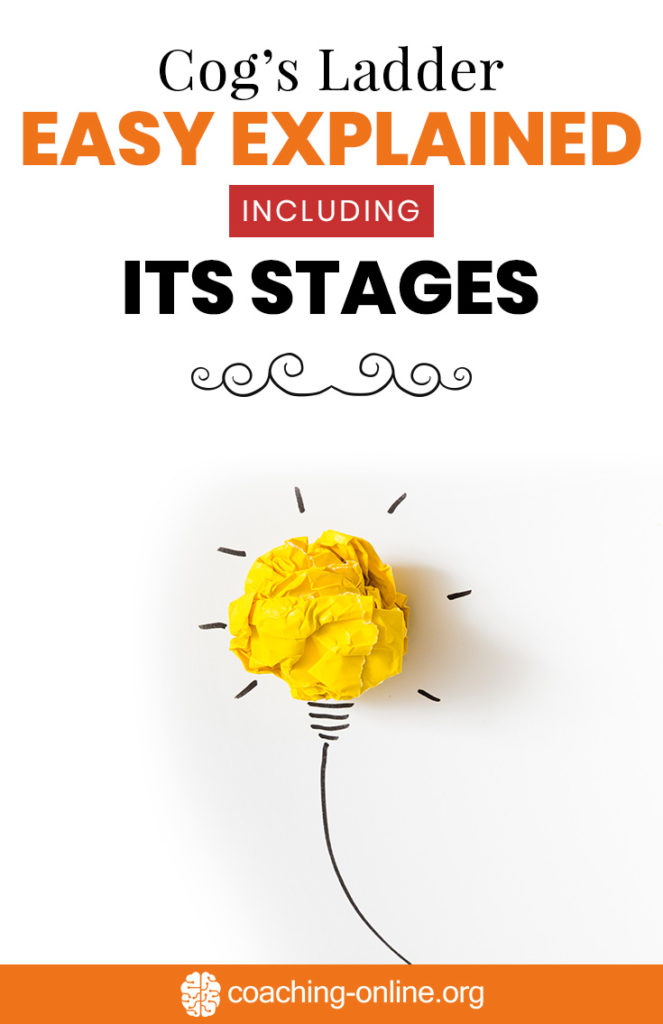In this article, we explain Cog’s Ladder, the 5 stages of the ladder, and why Cog’s Ladder is useful.
We also look at what makes a good team, the main functions of any group, and how to develop and strengthen a team.
What is Cog’s Ladder?
Cog’s Ladder is a model representing the development of a group that was developed by Procter and Gamble manager, George Charrier, in 1972.
This tool was first used as a guide to help P&G managers understand how a team works in order to successfully attain their goals.
For a group to be efficient and successful, Charrier believed that they undergo a process that starts from their initial meeting.

What Are the 5 Stages of the Cog’s Ladder?
In the Cog’s Ladder model, it is assumed that a group undergoes development in five stages:
- The Polite Stage.
It is only natural for group members to be awkward during the initial meeting.
At this stage, they are still getting to know each other, thus, playing it safe to earn the approval of others.
This is also where the judgments of other members are formed. - The “Why We Are Here?” Stage.
The second stage of the Cog’s Ladder is where the team’s objectives are laid out by the leader now that they know who they are working with.
The perspective is now shifted from individualism to group.
At this point, members are starting to communicate effectively. - The Power Stage.
The race for power is evident in this stage as members tend to get competitive.
Although conflict and struggle among the team are inevitable, this is important in the development of the team.
Solutions might not arise from the situation but the roles of each member will be established. - The Cooperation Stage.
Now that the hierarchy of the team is set, they can work towards their objectives.
At this stage, the group will realize that in order to meet their objectives, they need to work together to produce results.
The natural leaders of the group will take charge and others will contribute as well.
Introducing a new member during this stage is going to be a challenge as they will be viewed as an outsider. - The Esprit de Corps Stage.
This is the final stage wherein the group is working effectively as a team.
Communication is flawless and everyone is being productive.
However, not all groups are able to reach this stage due to several factors such as the introduction of a new member late in the process or the group has not established their roles in the earlier stages.
Related: The GRPI Model for Effective Teams – Easy Explained
Why is Cog’s Ladder Useful?
Cog’s Ladder is a useful tool to reflect on the development and progress of a team.
It is also very beneficial in determining the personalities of each member of the group and what their roles are.
By using this team development model, a manager can effectively distribute the workload and, eventually, meet their objectives and goals.

What Makes a Good Team?
The foundation of a well-performing business is a good team. What makes a good team?
There is no single solution to form and manage a team since every group will have members with different personalities and behavior.
But most successful teams display the following six characteristics that make them very effective:
- Effective communication.
This is an essential characteristic of a good team.
A team that is open for discussion and sharing of ideas and opinions will work efficiently.
Poor communication will only lead to misunderstandings and conflicts among members. - Goal-oriented.
A good team sets clear goals for them to achieve.
This allows them to craft a plan that allows everyone to contribute.
This also allows everyone to be held accountable and responsible for the team’s success. - Diversity.
Team members usually have different strengths and weaknesses but these allow them to offer different experiences and ideas to the group. - Leadership.
A team will not be able to function well if there is no leader.
A good leader is responsible for setting the pace, motivating the members, and providing constructive criticisms and feedback.
However, a leader should also be open to criticisms and feedback from the other members so that there is open communication between them. - Trust, respect, and support for each other.
A team without trust and respect cannot work effectively.
These two qualities are very important in order to show that other members can be relied on.
Supporting each other is also important in a team.
While they have their own roles, it will also be more productive when they assist those who are in need. - Manages conflicts effectively.
Sometimes, conflicts are unavoidable especially when working with a team.
This is where a team leader should step in and handle the situation.
Conflict allows members to grow and they can use it to reflect on their behavior.
A leader should not ignore whenever conflict arises and let others speak their minds while also giving them feedback in return.
Related: What Are Examples Of Effective Team Dynamics
What Are The Components Of Group Structure?
A group is organized and has structural variables that constitute the group’s overall structure.
The structure allows the members to understand their roles and behavior expected from them.
The components of a group structure are the following:
- Roles – the set of behavioral patterns associated with someone occupying a given position in a social unit.
- Norms – acceptable standards or rules of behavior that are shared by other members.
- Status – a socially defined position or rank given to groups or group members by others.
- Conformity – yielding to a group’s norms due to the desire of being accepted.
- Size – smaller groups tend to be faster in completing tasks while larger groups are better when it comes to decision-making.
- Cohesiveness – the degree to which group members are attracted to each other and motivated to stay.

What Are The Main Functions Seen In Groups?
Every group has functions that help them realize their goals. Here are the main functions of groups in an organizational setting:
- Establishing leadership
- Setting goals
- Making decisions
- Defining boundaries
- Controlling behavior of group members
Related: TOP Team Building Consulting Firms You Should Know
What Are 3 Strategies For Strengthening Teams?
A team can make or break the performance of a business which is why it’s important to have good teamwork among members.
Here are three strategies that can help in strengthening a team:
- A team should have clear goals.
It is important that a team understands its goals and how they achieve them. - There is a proper delegation of responsibilities.
Since every member has different experiences, a leader should know what roles to assign to them.
The strengths and weaknesses of the members come into play and a leader will have to decide on their roles based on these. - There should be proactive feedback.
Open communication is very important in a team.
Feedback helps in preventing misunderstandings among all members and promotes healthy discussion that strengthens the team in all aspects.
How Do You Create An Effective Team Environment?
The work environment is a great factor in the performance of a team.
If there is great pressure surrounding the team, it might be stressful for team members which can lead to poor performance.
In order for a team to be effective, the environment should be as well.
Below are some tips to create a good environment for a team:
- Establish strong leadership
- Create open and clear communication
- Establish team goals
- Encourage team members to contribute
- Encourage trust and cooperation
- Build a connection among team members
Related: Be, Do, Have Model Simplified – 12 Facts To Know

Related: Ways To Credible Leadership
Are There Other Theories Of Team Development?
Teamwork is very important for a business to perform well.
A team that has a strong connection with each other can function to achieve their goals.
In order to ensure that a team is making progress, managers normally refer to different team development models to understand the members’ behaviors and the current situation they are in.
Charrier’s Cog’s Ladder model is not the only team development model that managers use.
Aside from it, there is another model that is associated with Cog’s Ladder and that is Tuckman’s Model of Team Stages.
What is the Tuckman Model?
In 1965, psychologist Bruce Tuckman coined the memorable phrase “forming, storming, norming, and performing”.
It was only in the 1970s that he added the fifth and last stage which is “adjourning”.
According to Tuckman, these stages describe the progress of a team on their path to high performance.
Related: Integrated Leadership: Ideas To Be A Better Leader
What Are The Five Stages Of The Tuckman Model?
- Forming.
At this stage, the leader should be the one to facilitate as the roles of the members are not clear yet and they are still introducing themselves. - Storming.
This is the stage wherein the members start to push the boundaries to establish their roles in the group. Usually, conflicts arise during this stage. - Norming.
This is where the members resolve their differences and begin to accept each other. Communication among the members will start to develop. - Performing.
When the team reaches this stage, they will now have a better understanding of their goals and be able to work effectively towards it. - Adjourning.
Teams are not permanent and there will come a time when the members will have to say goodbye to each other and start over with a new team.

Related: Group Polarization – 11 Strategies To Avoid It (Backed By Science)
How Do You Use Tuckman’s Model?
To use Tuckman’s Model of Team Stages, a team leader should determine the stage where the team is currently at.
After determining this, the leader should apply strategies that will help the team move towards the next stage.
For example, if a team is still in the Forming stage, a leader should set clear objectives and direct them towards it.
If a team is in the Storming stage, conflicts should be resolved and trust should be established among members.
In the Norming stage, a leader should let the members fall into their roles and take responsibility.
If a team is already in the Performing stage, tasks should be delegated so the leader can also focus on other strategic issues.
If a team has achieved its goals and has already reached the final stage, it is important to celebrate the milestone and will help in remembering the experience positively.
Related Posts
How Much Does A Business Coach Cost?
What is Leadership Development Coaching?
